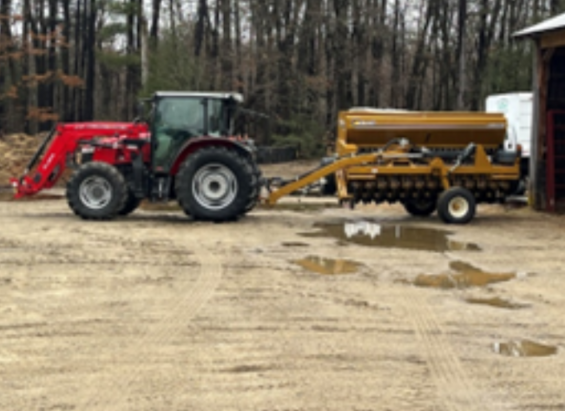The Challenge
According to the Healthy Soils Action Plan, row crops like vegetables, grains, and silage corn along with other crops that typically depend on regular cultivation, tillage, or other soil disturbance occupy 69,868 acres in Massachusetts. The accumulation of organic matter through healthy soils practices provides valuable and cost-effective carbon removal and storage and help reduce greenhouse gas (“GHG”) emissions.
According to the USDA Climate Hub, conventional tillage practices - which entail the mechanical mixing and turning of the soil with a plow or other implement to prepare the field for planting - can leave soil vulnerable to wind and water erosion, high temperatures and moisture loss. Minimizing soil disturbance through conservation tillage practices improves soil health, reduces the release of greenhouse gases (“GHG”) into the atmosphere and retains carbon in the soil. Conservation or reduced tillage practices are a healthier approach to soil management but require specialized equipment such as no-till drills. A barrier for growers to transitioning to reduced tillage or no-till practices is the cost of new equipment.
MDAR funds a range of project under its Climate Smart Agriculture Program (CSAP). The ResilientMass funding enabled more growers to acquire equipment to help with practices such as cover cropping, reduced, or no-till systems, as well as other climate adaptation and/or mitigation projects.
Project Scope
Climate-smart management practices can help Massachusetts farms become more resilient carbon sinks by promoting healthy soils.
Practices such as no- or low-tillage, cover cropping, and improved nutrient management can help retain carbon in the soils and decrease emissions from farming. CSAP has focused the ResilientMass implementation funding on helping farmers acquire no-till drills. No-till Drills have been a priority project for the seeding of cover crops. No-till drills are often used for the planting of smaller seeds, like single or multi-species cover crop mixes, while no-till planters are used for larger seeds such as corn, or soybeans and that require more accurate spacing and seed depth. Cover cropping provides many benefits, and these benefits accumulate over the years they are used. Cover crops reduce the need for herbicides, and pesticides, cut fertilizer costs, enhance soil-health, prevent soil erosion, and protect water quality. The no-till equipment was funded in FY 2024 for subsequent implementation.
Metrics
Successful implementation of CSAP through application, review, funding award and completion of projects.
Part I: Adaptation & Mitigation: Fifty-nine (59) proposals were submitted with requests totaling $2,061,266. Twenty-eight (28) projects are recommended for funding in the amount of $1,000,000. From those 28 projects, the following 7 were awarded with ResilientMass funding, totaling $250,000.
Results
Benefits of Using a No Till Drill:
- Reduces soil loss due to erosion
- Minimizes disruptions to soil aggregates by not breaking them up continuously & forcing them to restart.
- Can increase soil organism diversity & activity
- Does not disrupt earthworm burrowing and helps protest networks created mycorrhizal fungi that connect them to the host plant
- Can slightly reduce soil temperatures
- Reduces fuel and labor costs by decreasing the number of passes through the field with tilling (~$100 per acre for each crop planted)
- Reduces the wear and tear on equipment
- Saves time by requiring less ground preparation before planting
These are photographs of No-till Drill machinery used for planting cover crops:

Figure 1. - Photograph of No-till Drill machinery used for planting cover crops.

Figure 2. - Photograph of No-till Drill machinery used for planting cover crops.
Best Practices and Lessons Learned
There is a need for more technical assistance and further quantifications of the benefits as related to farm use and sequestering carbon. The adoption rates of no-till planting and cover cropping have risen significantly in the past years as more funding and efforts have prioritized the benefits of soil health practices.
Although there are obvious benefits to the use of this equipment and the increase in farm utilization of soil health practices, there is still a need for more technical assistance in terms of quantification of practices used, acreage amounts, cover crop types, as well as overall equipment management and use.
Project Alignment with ResilientMass Plan Priority Actions
The Healthy Soils Action Plan is cited as an example of federal, state, regional, and local efforts to support hazard mitigation and climate adaptation in Massachusetts. It is also noted that healthy soils are a component of cross-government ACTION 13: Protect 30 percent of land and ocean by 2030 (to align with the global 30x30 goal). The projects funded in CSAP help advance healthy soils practices on cropland.